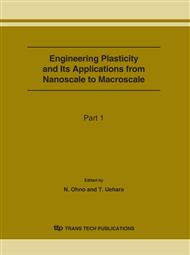p.1025
p.1031
p.1037
p.1043
p.1049
p.1055
p.1061
p.1067
p.1073
A Polycrystalline Analysis of Hexagonal Metal Based on the Homogenized Method
Abstract:
In this study, a three-dimensional finite element formulation for polycrystalline plasticity model based on the homogenization method has been presented. The homogenization method is one of the useful procedures, which can evaluate the homogenized macroscopic material properties with a periodical microstructure, so-called a unit cell. The present study focuses on hexagonal metals such as titanium or magnesium. An assessment of flow stress by the presented method is conducted and it is clarified how the method can reproduce the behavior of hexagonal metal.
Info:
Periodical:
Pages:
1049-1054
Citation:
Online since:
June 2007
Price:
Сopyright:
© 2007 Trans Tech Publications Ltd. All Rights Reserved
Share:
Citation:


